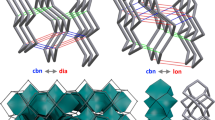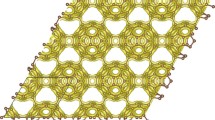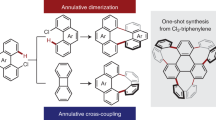Abstract
The nucleation and growth of curved carbon structures, such asfullerenes, nanotubes and soot, are still not well understood. Avariety of models have been proposed1,2,3,4,5,6,7,8,9,10,11,12,13,14,15,16,17, and it seems clear that the occurrence of pentagons, which yield 60° disclination defects in the hexagonal graphitic network, is a key element in the puzzle. The problem of nucleation has been complicated by the great variety of structures observed in any one sample. Here we report an unusual carbon sample generated by pyrolysis of hydrocarbons, consisting entirely of graphitic microstructures with total disclinations that are multiples of +60°. The disclination of each structure corresponds to the presence of a given number of pentagons in the seed from which it grew: disks (no pentagons), five types of cones (one to five pentagons), of which only one was known previously18, and open tubes (six pentagons). Statistical analysis of these domains shows some unexpected features, which suggest that entropy plays a dominant role in the formation of disclinations. Furthermore, the total disclination of a domain is determined mainly at the nucleation stage.
This is a preview of subscription content, access via your institution
Access options
Subscribe to this journal
Receive 51 print issues and online access
$199.00 per year
only $3.90 per issue
Buy this article
- Purchase on Springer Link
- Instant access to full article PDF
Prices may be subject to local taxes which are calculated during checkout




Similar content being viewed by others
References
Zhang, Q. L. et al. Reactivity of large carbon clusters: spheroidal carbon shells and their possible relevance to the formation and morphology of soot. J. Phys. Chem. 90, 525–528 (1986).
Kroto, H. W. & McKay, K. The formation of quasi-icosahedral spiral shell carbon particles. Nature 331, 328–331 (1988).
Smalley, R. E. Self-assembly of the fullerenes. Acc. Chem. Res. 25, 98–105 (1992).
Wakabayashi, T. & Achiba, Y. Amodel for the C60 and C70 growth mechanism. Chem. Phys. Lett. 190, 465–468 (1992).
Robertson, D. H., Brenner, D. W. & White, C. T. On the way to fullerenes: molecular dynamics study of the curling and closure of graphitic ribbons. J. Phys. Chem. 96, 6133–6135 (1992).
Endo, M. & Kroto, H. W. Formation of carbon nanofibers. J. Phys. Chem. 96, 6941–6944 (1992).
Iijima, S., Ajayan, P. M. & Ichihashi, T. Growth model for carbon nanotubes. Phys. Rev. Lett. 69, 3100–3103 (1992).
Saito, Y., Yoshikawa, T., Inagaki, M., Tomita, M. & Hayashi, T. Growth and structure of graphitic tubules and polyhedral particles in arc-discharge. Chem. Phys. Lett. 204, 277–282 (1993).
McElvany, S. W., Ross, M. M., Goroff, N. S. & Diederich, F. Cyclocarbon coalescence: mechanisms for tailor-made fullerene formation. Science 259, 1594–1596 (1993).
von Helden, G., Gotts, N. G. & Bowers, M. T. Experimental evidence for the formation of fullerenes by collisional heating of carbon rings in the gas phase. Nature 363, 60–63 (1993).
Hunter, J., Fye, J. & Jarrold, M. F. Carbon rings. J. Phys. Chem. 97, 3460–3462 (1993).
Harris, P. J. F., Tsang, S. C., Claridge, J. B. & Green, M. L. H. High resolution microscopy studies of a microporous carbon produced by arc-evaporation. J. Chem. Soc. Faraday Trans. 90, 2799–2802 (1994).
Gamaly, E. G. & Ebbesen, T. W. Mechanism of carbon nanotube formation in the arc discharge. Phys. Rev. B 52, 2083–2089 (1995).
Charlier, J. -C., De Vita, A., Blase, X. & Car, R. Microscopic growth mechanisms for carbon nanotubes. Science 275, 646–649 (1997).
Achiba, Y. et al. in The Chemical Physics of Fullerenes 10 (and 5) Years Later (ed. Andreoni, W. 139–47 (Kluwer Academic, Dordrecht, (1996)).
Lahaye, J. & Prado, G. in Particulate Carbon (eds Siegla, D. C. & Smith, G.W.) 33–55 (Plenum, New York, (1981)).
Harris, S. J. & Weiner, A. M. Chemical kinetics of soot particle growth. Annu. Rev. Phys. Chem. 36, 31–52 (1985).
Ge, M. & Sattler, K. Observation of fullerene cones. Chem. Phys. Lett. 220, 192–196 (1994).
Ihara, S., Itoh, S., Akagi, K., Tamura, R. & Tsukada, M. Structure of polygonal defects in graphitic carbon sheets. Phys. Rev. B 54, 14713–14719 (1996).
Ebbesen, T. W. in Carbon Nanotubes: Preparation and Properties (ed. Ebbesen, T.W.) Ch. 4 (CRC, Boca Raton, (1997)).
Acknowledgements
We thank M. E. Bisher for technical assistance.
Author information
Authors and Affiliations
Author notes
Correspondence and requests for materials should be addressed to T.W.E.
Rights and permissions
About this article
Cite this article
Krishnan, A., Dujardin, E., Treacy, M. et al. Graphitic cones and the nucleation of curved carbon surfaces. Nature 388, 451–454 (1997). https://doi.org/10.1038/41284
Received:
Accepted:
Issue Date:
DOI: https://doi.org/10.1038/41284
This article is cited by
-
Effects of atomic vacancy defects and their evolution mechanisms on the fracture of carbon nanotubes
Journal of Materials Science (2024)
-
Nano-oscillators based on a C60 fullerene inside open carbon nanocones: a molecular dynamics study
Journal of the Brazilian Society of Mechanical Sciences and Engineering (2020)
-
Modelling carbon nanocones for selective filter
Journal of Mathematical Chemistry (2020)
-
The Magnetic Properties of the Spin-1 Ising Fullerene Cage with a Core-Shell Structure
Journal of Superconductivity and Novel Magnetism (2019)
-
Evolution of glassy carbon under heat treatment: correlation structure–mechanical properties
Journal of Materials Science (2018)
Comments
By submitting a comment you agree to abide by our Terms and Community Guidelines. If you find something abusive or that does not comply with our terms or guidelines please flag it as inappropriate.



